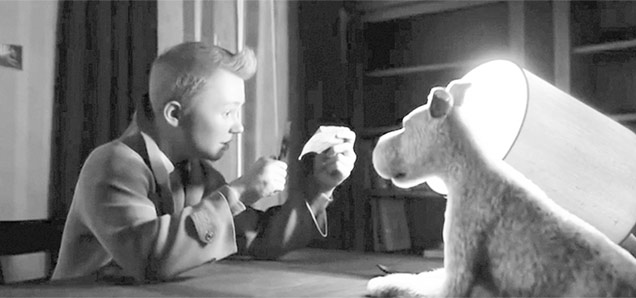Reel Life: Tintin goes Hollywood; for those who can't pick up the books
 CREDIT: THE ADVENTURES OF TINTIN
CREDIT: THE ADVENTURES OF TINTINHow real is too real? The realistic-but-not-quite look of the 2011 Tintin movie might be a bit off-putting to some.
Undoubtedly, Tintin being a massive comic book franchise, the inevitable adaptations come in tow. But as a fan (or perhaps a newbie), where does one start?
Well, anything goes, but remember that the adaptations come with a certain crudeness that show their age.
The Adventures of Tintin (2011)
Probably the most recent and well-remembered, and maybe the most divisive among fans. Although it manages to retool three Tintin stories (Crab with the Golden Claws, Red Rackham's Treasure, Secret of the Unicorn) into an excellent and relatively gunk-free plot, the animation is probably the most polemic element of the film. Some may remember Polar Express and its rather creepy, realistic animated human characters, pushing the film into uncanny valley territory. While the Tintin movie attempted to fix that rather egregious problem with its more relaxed, cartoonized approach to character design, some felt that the creepiness was only further exacerbated by the unrealistic- looking characters possessing all-too-real looking hair and skin. If you can see past this, The Adventures of Tintin is an otherwise fine adventure movie that still has some of the Tintin spirit.
The Adventures of Tintin: The Animated Series (1991 to '92)
Best remembered from its syndicated re-runs, the '90s animated series was incredibly ambitious, in seeking to adapt every single one of the Tintin comics, and it's still the most faithful adaptation to date.
The animation is kind of crude by today's standards, and there are a LOT of visible technical mistakes, but you can't fault them considering the volume of one-hour episodes (39, to be exact) produced in the space of two years in the '90s... before fancy computer animation and digital inking.
Although a lot of the violence, deaths and general use of alcohol was toned down (Haddock's drunken shenanigans aren't quite kid-friendly, it would seem), the stories themselves are relatively intact. In fact, only three remain non-adapted, (Tintin in the Land of the Soviets, Tintin in the Congo, Tintin and the Alph-art), out of which two were deemed too offensive to even bother, and another was simply unfinished work by Herge. Take a guess.
The Odds and Ends
Really, with the above two, you'll get as much Tintin as you want without actually picking up any of the books, but then come the odd bits, either original stories or older adaptations of comic stories. Their oddness lies in their methods by which they translated the Tintin characters; Tintin, Snowy, Captain Haddock, Professor Calcus, from page to screen.
Tintin live-action films (1960s)
Yes, in the 1960s, someone thought that animated Tintin stories were too pass�, and that having two live-action films were definitely the best way to display the exploits of the young journalist.
Entirely in French, both original stories rather than being based on existing comics (Temple of the Golden Sun and The Blue Orange), their entertainment value lies mostly in their campiness. These two films are just weird, in an Adam West Batman sort of way. The degree of faithfulness in translating the comic book characters' goofy and exaggerated appearances into real-life actors adds a layer of cartoonish surrealism to the films. If you're francophone or don't mind subtitles, give these two films a shot.
Crab with the Golden Claws (1947)
Like the very first Tintin comic, the very first Tintin comic adaptation is quite crude and sticks out rather sorely against its future compatriots. An entirely stop-motion cartoon adaptation of the eponymous comic, the limited and cheap animation only makes the cartoon fail in capturing the intensity of the Tintin storyline. Interpreting it as a work of alternative art puts a whole other spotlight to it, however. The rickety miniature sets, the doll-like, barely-moving stop-motion puppets, and the intersped use of live stock footage add a Dadaist feeling to the whole thing.













